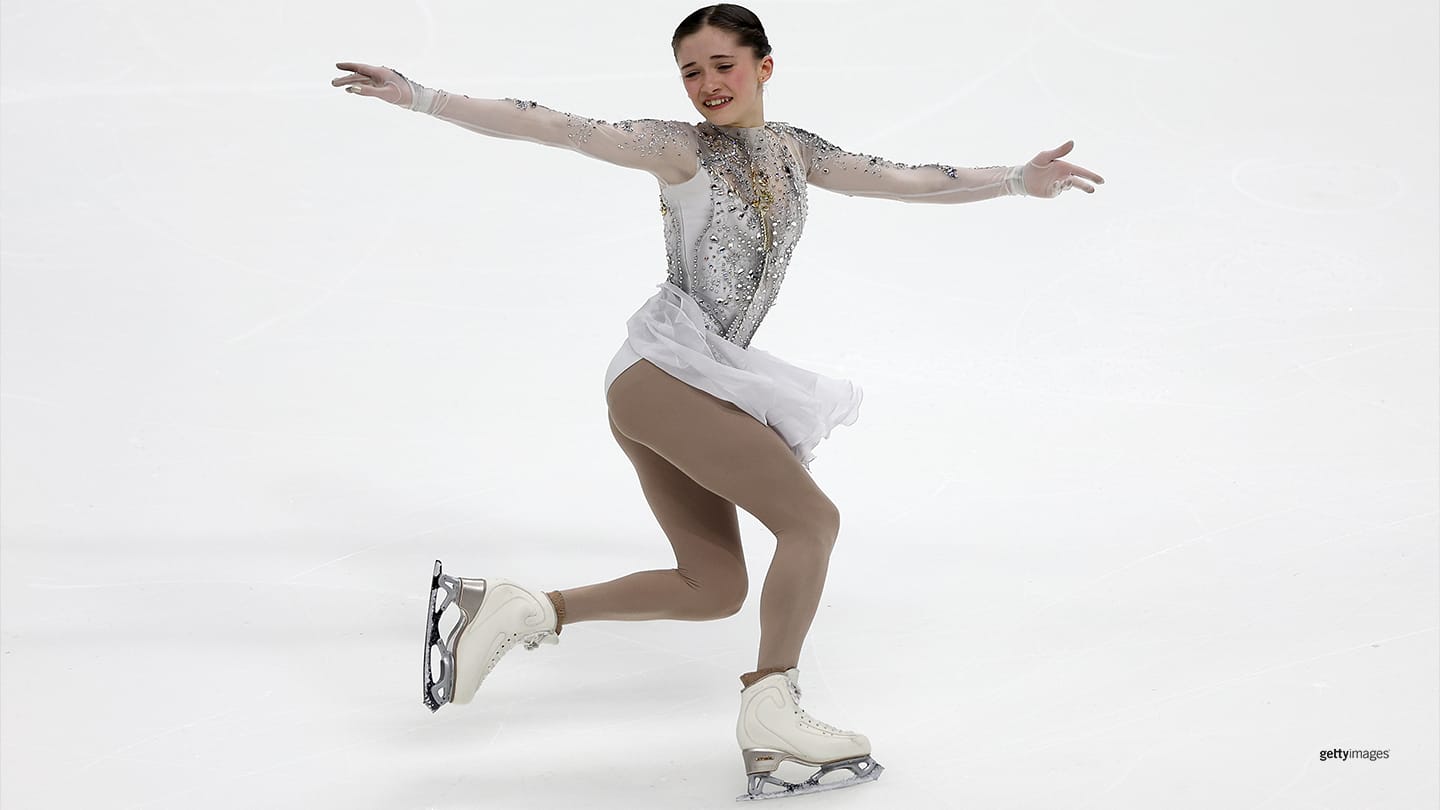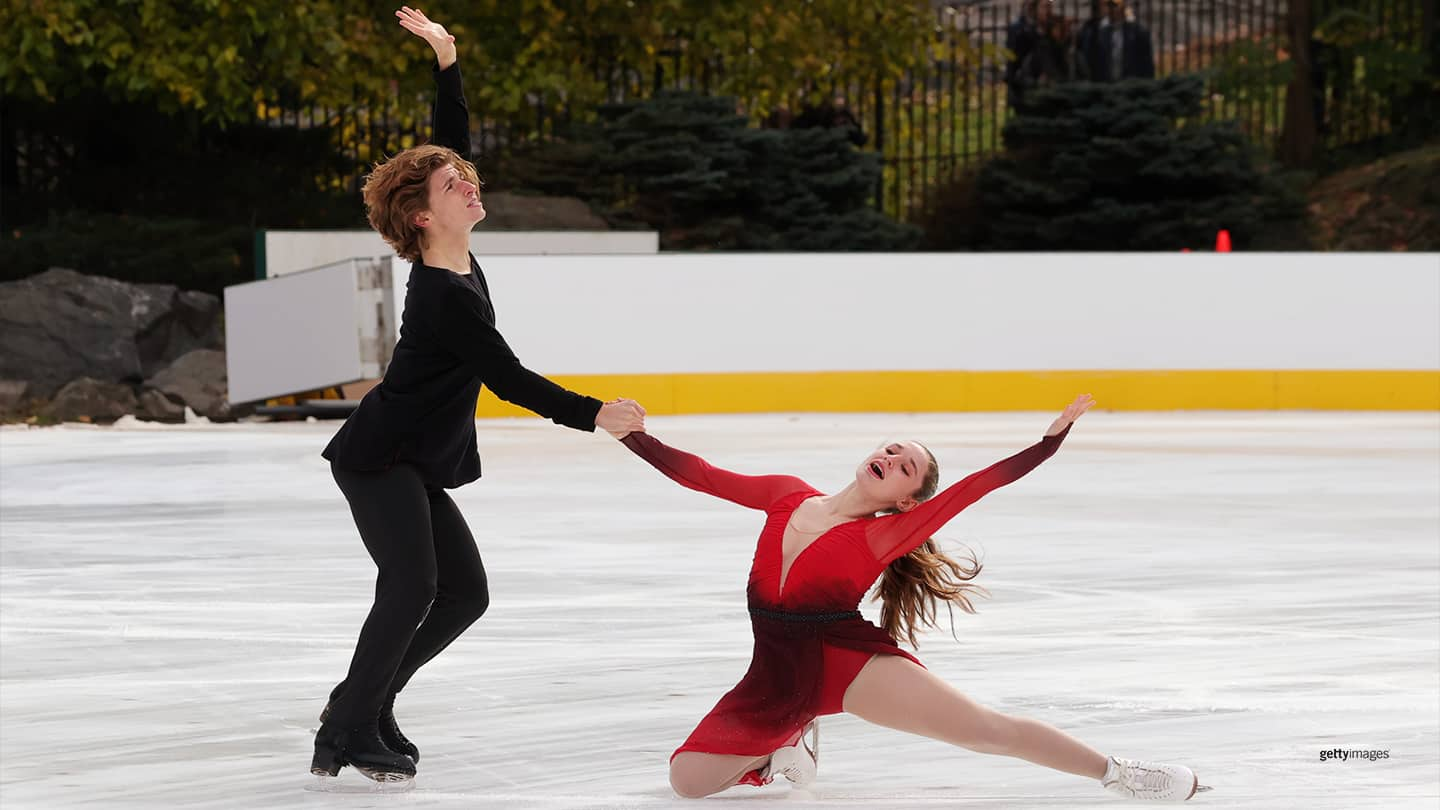
2023 Toyota U.S. Figure Skating Championships: Night 1 Preview
by Lynn Rutherford

Isabeau Levito skates in the ladies short program during the U.S. Figure Skating Championships on Jan. 6, 2022 in Nashville, Tenn.
SAN JOSE, Calif. – “Unpredictable” only begins to describe the women’s event at the U.S. Figure Skating Championships.
When the short program kicks off the women’s competition this evening in San Jose, it will be without last year’s Olympians, Mariah Bell, Karen Chen and Alysa Liu. The turnover, combined with some strong up-and-comers, has created even more wide-open U.S. Championships than is usual in this first year of the new Olympic quad.
“It’s any of the ladies’ game, whoever stands up and skates well — everything is up for grabs,” said coach and choreographer Rohene Ward, who works with several athletes competing here. “It’s refreshing because we’re so used to predicting and everyone going, ‘Oh, these are going to be the top three.’”
Isabeau Levito, the 15-year-old junior world champion who placed second at the Grand Prix Final last month, is favored to win. The skater from Mt. Holly, New Jersey, has been consistent through five events this season, but will her competitive nerve hold fast under the unique glare of the U.S. Championships?
Not all of the contenders are new faces, per se.
Two-time U.S. champion Bradie Tennell, 24, returns after missing last season with a foot injury. Starr Andrews, 21, is having her best season ever, including a silver medal at Skate Canada. After a bronze medal at Skate America, Amber Glenn, 23, was disappointed with her program. But, the explosive jumper could rebound, especially if she lands her triple axel. Another two-time U.S. champion, 2014 Olympian Gracie Gold, 27, battled an eating disorder, anxiety and depression to continue in the sport, and is sure to be a crowd favorite.
Then there are new (or newish) faces that can crash the medal party, plus a few dark horses. Audrey Shin, an 18-year-old from Long Island, New York, counts herself among the latter.
“I’ve had a good season so far, I got top four in both of my Grand Prix, so that is definitely a confidence booster for me,” she said. “I do want to say I see myself in the top with all of the other skaters here. I want to prove to myself that I can be one of the best ones out there.”
Shin adopted a new persona — “a really flirty and aggressive character” — in her tango short program, breaking new ground as a performer. She and her coach, Tammy Gambill, have focused on getting her jumps clean.
“We’ve been working hard on making all of my jumps (fully) rotated, just polishing every jump, doing it over and over again, to get that repetition and good feeling on all of them,” she said. “I’m planning to do my triple toe-triple toe in the second half of the free program. I attempted that at NHK (Trophy) and it was a little under rotated, but we’ve been working hard on it for nationals.”

Audrey Shin skates in the ladies short program during the U.S. Figure Skating Championships on Jan. 6, 2022 in Nashville, Tenn.
Triples with three complete revolutions and no deductions from the technical panel will play a big role in placements. Competing in her first nationals as a senior, Ava Ziegler, 16, thinks her big jumps might give her an edge.
“Placing top three is definitely in my head, and it will take being clean in both programs,” Ziegler, last season’s U.S. junior silver medalist, said. “Leading into San Jose, my practices have been really successful, and I’m happy about that.”
“I would say seven or eight skaters can win those spots,” said Steven Rice, who coaches Ziegler in Hackensack, New Jersey. “The top three from past seasons (Bell, Chen and Liu) have retired, or aren’t competing here. Everyone in the group has had some ups and downs on the international scene, so it’s up to Ava to go out there and deliver two great performances.”
Ziegler’s mom, Patricia Mansfield Ziegler, competed at five U.S. Championships, placing fifth in 1995. Her advice to her daughter?
“Go be you, you’re beautiful, go be your art piece, be aggressive — you know what you can do, go deliver,” Patricia said.
Lindsay Thorngren, who placed fifth in the U.S. last season and recently won her first international senior title in Croatia, trains alongside Ziegler at the Ice House in Hackensack and is very much in the running for a medal. All told, nine skaters from the Hackensack rink earned trips to San Jose.
“It’s such a great atmosphere, because everyone just is so supportive,” Ziegler said. “We all understand what we all go through. That’s amazing, because a lot of people don’t get this.”
The list goes on. Last season’s junior U.S. champion, Clare Seo, makes her national senior debut, as does the 2022 U.S. junior bronze medalist Josephine Lee, who looks sharp in her practices in San Jose.
“I’m excited with the fresh new faces, the fresh energy,” said Ward, whose own pupil, 19-year-old Alexa Gasparotto, will compete at the U.S. Championships for the first time. “I honestly can’t remember any ladies’ event as open as this one.”
When 15 ice dance teams compete in the rhythm dance this afternoon at the U.S. Figure Skating Championships in San Jose, all will interpret Latin American styles, ranging from the light and bubbly cha cha cha to the silky rhumba, a dance that often emphasizes amorous tension. The programs can be seductive, passionate, and intense — the epitome of the romantic relationship that often prevails in ice dance routines.
Not for Oona Brown and Gage Brown, the brother-and-sister ice dance duo from Long Island, New York, who stepped into the spotlight when they won the junior world title last April in Tallinn, Estonia.
“The Latin theme is very romantic based, so (the rhythm dance) this year was a bit challenging,” Gage, 20, said. “But even so, I don’t find it that limiting, maybe because we’ve been doing it for so long (since 2016). Styles like a tango are considered romantic, but you get to look fierce at each other, which is easy if you are brother and sister.”
“Sometimes, for the romantic parts, we project more out to the judges, than we do to each other,” Oona, 18, added.
Sibling teams have a long history of success in figure skating.
Of the five U.S. pairs that have won Olympic medals since World War II, three are brother-and-sister. In San Jose, Maria Mokhova and Ivan Mokhov, a sibling duo from Grand Rapids, Michigan, are dark horses for a pairs medal.

(l-r) Gage Brown and Oona Brown perform and ice dancing routine at the grand reopening of Wollman Rink NYC in Central Park on Nov. 14, 2021 in New York City.
The Browns count several sibling ice dance teams as role models. Two-time U.S. champions Maia Shibutani and Alex Shibutani’s familial bond and shared creative vision led them to the 2018 Olympic bronze medal. Scots Sinead Kerr and John Kerr, two-time European medalists for Great Britain, showed off creative storylines and bursts of humor.
“The Shibutanis did a really good job of making it comfortable for themselves, and comfortable for the audience,” Gage said. “The Kerrs, we watched at the very beginning of our careers, and we looked up to them. Those are the two teams that we, I don’t want to say modeled ourselves on, but we took things from them.”
Now a coach and choreographer based in New Jersey, Sinead Kerr recalled how she and John created their programs.
“We tried to explore new ways of showing a relationship that wasn’t romantic, and we would try to evoke a bit of playfulness into everything we did,” she said. “I think we drew on the strength that skating is part acting and telling a story, and when you’re telling a story on the screen or stage, nine times out of 10 you’re not involved (romantically) with your acting partner. … Our dynamic on the ice was, we’re telling a story, we’re doing this together and we’re doing it to win an event, to compete.”
Kerr considers the sibling relationship as a plus, especially when you’re training long hours together, day after day, year after year.
“There is a huge advantage in knowing the person, knowing what makes them tick, (being) confident that they are going to be there for you,” she said. “There is just a different bond and closeness with each other that is hard to match.”
Gage, the fourth child in a family of seven kids — Oona is the fifth — also thinks the advantages of being sibling ice dancers outweigh any challenges.
“For our mom, obviously, it was a lot easier because the team was in the car together, and she just made one drive to the rink,” he said. “Then there’s our synchronicity. We know each other so well, living together our whole lives, and I would consider that a very good asset.”
His younger sister was a bit less certain.
“I don’t know, I feel like there are advantages and disadvantages,” Oona said with a laugh. “Maybe some arguments will occur.”
“It does happen,” Gage agreed. “I feel like we do a pretty good job managing our time. … At the rink, we make it fun, we make it playful, we have a good time and then when we’re home, we do our own thing.”
“And having a lot of siblings helps with that because when you come home, you can hang out with your other siblings,” Oona added.
The Browns, who make their senior national debut this week, are realistic about their chances in San Jose. The transition from the junior to senior ranks is often difficult for ice dancers, who rely on maturity, musicality and presentation rather than the big technical tricks seen in singles and pairs competitions.
“It’s not necessarily like we’re trying to be top three in the country, which we know isn’t the most attainable for this season,” Gage said. “We’re focused on putting ourselves out there as a strong senior team, a team that’s in the top seven, six, maybe five.”
Madison Chock and Evan Bates, odds-on favorites to win their fourth U.S. title here, perform their rhythm dance to a samba and rhumba re-mix of David Bowie’s “Let’s Dance.” They will compete last in the lineup on Thursday, two spots after the Browns, who will share the warm-up ice with the three-time Olympians and world medalists. The siblings first shared the ice with Chock and Bates at U.S. Figure Skating’s Champs Camp last August and remain slightly starstruck.
“We managed to stay focused on what we needed to do on the ice, but still — they go by, they do some transition or element, and it’s, like, wow,” Gage Brown said.
Lynn Rutherford has covered five Olympic Games, including the 2022 Winter Games in Beijing for TeamUSA.org. Based in New York, she is a freelance contributor to TeamUSA.org on behalf of Red Line Editorial, Inc.